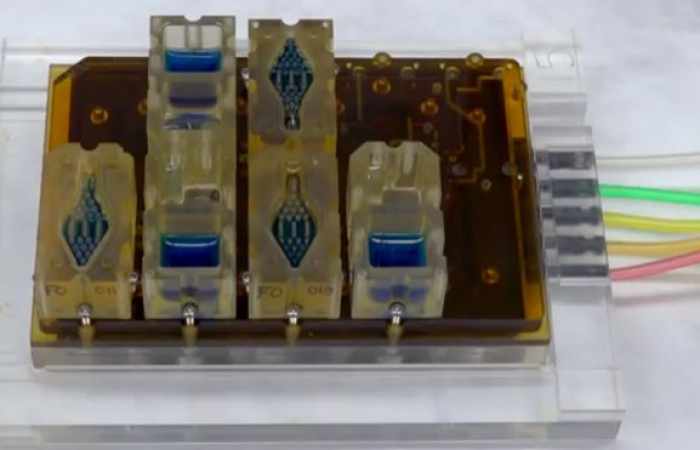It also provides a novel way to test new treatments.
The work is part of a project to create the entire human "body on a chip".
The ultimate goal would be to take cells from any given individual in order to create a personalised model of their body to test drugs and treatments on, Nature Communications reports.
Menstrual cycle in a dish
The 3D model is made up of a series of cubes that each represent the different parts of the female reproductive system.
Each cube contains collections of living cells from the respective bits of this system - fallopian tubes, uterus, cervix and vagina (all human cells), and the ovaries (taken from mice).
The cubes are connected together with small tubes, which allow special fluid to flow through the entire system, much like blood.
This also means the "mini organs" can communicate with each other using hormones, mimicking what happens in a woman's body during a "typical" 28-day human menstrual cycle.
One of the cubes represents the human liver because this organ plays an important role in drug metabolism, say the scientists.
Tests suggested that the tissues in the system responded to the cyclical ebb and flow of hormones, in a similar way to those of the female body.
Research Dr Joanna Burdette, from Northwestern University, said: "It's a biological representation of the female reproductive tract, so we call it Evatar."
Co-worker Dr Ji-Yong Julie Kim said: "Understanding how the uterus responds to hormones is really important. There is no animal model for a lot of the stuff that we study."
Experts welcomed the advance.
Prof Jan Brosens from the University of Warwick said: "This is genuinely a remarkable technical achievement.
"I am entirely confident that this novel technology represents a step-change in our ability to pinpoint defects that cause infertility and early pregnancy loss. However, it is not a system that can recapitulate all the specialised functions of the reproductive tract or replace IVF."
Dr Channa Jayasena, from Imperial College London and the Society for Endocrinology, said: "The results are exciting and represent an important innovation. However, we must remember that the rodent and human reproductive systems have important differences."
More about: #menstruation
















































